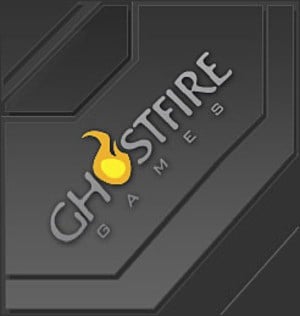
Find out what he had to tell WiiWare World in this exclusive interview:
WiiWare World: On the Ghostfire Games "Our Philosophy" page it talks about your fondest memories being of classic games that were simple and fun like Pac-Man and Super Mario Bros. Do you feel that video games have become too technical and complicated?
Ed Roman: That's a good question. I think some of the best games I've seen in recent memory are games that have been simple to learn, but difficult to master and I think that there have been a lot of games that have gotten very technical, but I think there are also a lot of games these days that are still kind of harkening back to the classic games. A good example of a game like this would be World of Warcraft, which is a game where you can pretty much right away get into it. You don't have to learn a complex user interface. Everything is mouse-driven and so I think that even today simplicity is really driving video games, so we defintitely followed that philosophy in our game. In our game there's no buttons at all. Our game is completely driven off of moving the Wii Remote through the air.
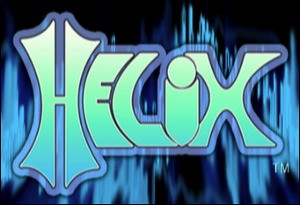
WW: Where did the idea for Helix originate?
ER: Quite frankly it was because we were pretty bored with going to the gym and exercising on a treadmill or lifting weights and we had seen the Wii being used for exercise, you know Wii Sports. It's a great exercise vehicle for the Wii. We're seeing video games evolve towards more than just entertainment and people are getting different kinds of value out of video gaming, so what we decided to do was make a game that focuses on exercise. Exercise is actually a secondary goal of our game. Our game is more slanted towards being a fun, entertaining experience. A fun game to play. If you burn some calories that's sort of a second side benefit that happens to happen as you play the game and we think that's the right way to make an exercise video game. To not make it like an exercise tape, like an exercise workout tape, but make it a video game that happens to burn calories as a side benefit.
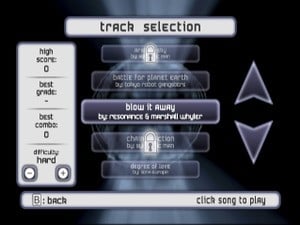
WW: Well you answered part of my next question which was to ask you if fitness is an aspect of Helix that you were actively promoting?
ER: We are. We're about to come out with another video that you'll see in about a week or so that basically explains our vision for the game as the exercise impact of the game is explained, but we're focusing more on the fact that the game is fun. It's a music rhythm game. It's got 26 songs in the game and 3 different difficulty levels. We're making more of a game where you kind of lose yourself and want to keep playing the next level. We haven't pinpointed fitness as much, but it definitely is a benefit of the game.
WW: Can you tell us a little about the actual game play in Helix?
ER: Yes. The whole idea behind the game is you see this robot on the screen and the robot does moves like punches, circles, and uppercuts and your job is to basically follow the robot. So it's similar to other music/rhythm games except instead of it being a dancing game, it's more of an upper-body workout game. The robot does his moves and after he does his moves you'll see what's called a "MOVE" bar appear on the top right of the screen. This move bar is your indicator for when it's your turn to do that move. The move bar starts drifting towards the center of the screen. When the move bar gets to the middle, that's when you perform the move. So it's very much like a simon-says style of game play where the robot does a move, you have to memorize the move he did, and then you have to imitate the move and repeat it when the move bar gets to the middle of the screen. Then when you get on more challenging difficulty levels, instead of it being a simon-says type of game play, it's much faster and becomes continuous where you have to memorize the next move while repeating the previous move. So instead of being like simon-says, it's more fluid motion and it becomes very hectic very quickly.

WW: Can you tell us a little about the music used in the game such as how songs were submitted to your company and how difficult it was to narrow it down to 26 tracks?
ER: Originally our goal was to make a game that had 12 songs in it. We think that for a $10 WiiWare game that would be enough value to justify that price. It was always challenging to figure out how we were going to fit that much music in a 40MB download. I don't know if you're familiar with MP3's and how big those things are, but even if we had 12 songs that would fit into 40 megs right there and that wouldn't leave any room for the programming or the graphics or anything like that. The first thing we did when we got the music was explored a lot of compression technologies and we found a very cool technology that allows us to actually get a 4-to-1 compression ratio, so we're actually able to include 26 songs instead of twelve songs and still have it fit into 40 megs. The sound quality is actually amazing, it sounds just like an MP3. You can't really tell the difference at all, so we were able to include over double the amount of available tracks as we wanted to.
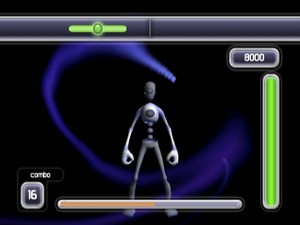
The music itself came from artists all over the world. We had music from Europe, Russia, and the United States. These are independent musicians, people who make awesome music but aren't quite as famous as some of the headliner bands here in the United States. Since we're a small start-up company we really can't afford to license some of the more headliner band music. We had to get creative and look towards more independent music. This independent music is actually fantastic. It's actually music that I think is as good as some of the headliner bands in the West, there just not as famous yet. So what we're hoping is that people that play our game will get exposure to this type of independent music and it will sort of widen their eyes as to what music is out there. We think the quality of the music in the game is probably the best aspect of the game. Every single track has been hand-picked and it sounds just amazing. That's one of the things we like the best about the game.
WW: Were there any special animation techniques used to create the onscreen movements of the robots?
ER: We animated that robot by hand. We did go for a style of robot whose arms are very long so that it's very easy for you to tell what move the robot is doing. The robot almost has a cartoon shading style to him. One of the interesting things about how the robot moves and how you imitate his moves is the way the input of the game works. You know how Wii games these days struggle sometimes with their input. A lot of games for the Wii have been criticized for having bad input where people try to do moves and they don't get registered properly. This is a common criticism of Wii games, so one thing we tried to do was first of all we tried to make the animation moves be as simple and crisp as possible so that it would be really easy for you to figure out what you have to do. The second thing we do is we actually motion-capture the users own moves and then compare them to your own motion capture data when you play the game. That way the user has an experience that's customized to himself. So for example we have in our menu a button called "calibrate." This calibration is you are automatically showing the game how you do a punch, how you do a circle, how you to a backspin. Then later on when you play the game your moves from when you're playing the game are then compared to your own motion-captured moves that you did during calibration. That way it's like a specific experience tuned for yourself.
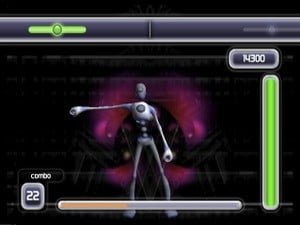
WW: Will Helix feature any online play or other options?
ER: What we're going to have is instead of online, we have a multiplayer game. The way the multiplayer game works on the same console is that each player holds one Wii Remote and is responsible for one arm of the robot. It's actually a really fun way to play the game and it's pretty hilarious. You're kind of acting like a double-headed robot at that point. You can't help but smile when you play the game this way because you can imagine if the robot does a double punch forward with each of his hands both players have to punch forward at the same time. It's actually really fun.
WW: What are some of the challenges you've faced as a developer in having to deal with the file size limitations of the WiiWare service?
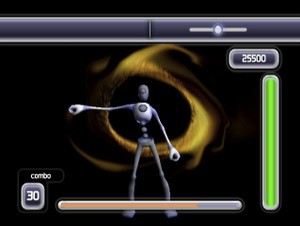
ER: Well you know I told you a little bit earlier about the 40MB limit and trying to fit all of the music into the game, and the compressions is how we dealt with that. We kept the graphics really simple so that we could fit into 40 megs and then the other thing we did, which is really cool, is using technology to actually animate the graphics of the game behind the robot. The visual effects happening behind the robot, those are being animated to the beat of the music. As the music plays, the graphics in the background pulse to that beat of the music and we're using a similar technology to what's found in music visualization software. Like where you play MP3's and you see the music visualized, we're using that type of technology and that's how we save on space. Instead of creating a lot of custom graphics, we have the music sort of create the graphics for us.
WW: Will there be any add-on content, such as additional song titles, available for download on the WiiWare service?
ER: Instead of doing expansion packs, what we've decided to do is, at some point, to do a sequel to the game. So that way the user is getting more value. We weren't really sure which way to go. Originally we were thinking about doing content packs, but we decided to instead focus on a sequel at some point.
WW: What are some of the key advantages for you as a developer in creating games for the WiiWare service as opposed to creating an actual retail release?
ER: It's huge. Making a WiiWare game allows a start-up company like us to actually get into the games industry and create games without having millions of dollars to do it. We built this game at a budget of around $150,000 and got two programmers, a producer, two level designers, and we've got an artist and an animator and that's it. That's our entire team. And since customers expect a little less value out of a $10 product versus a $50 product, it actually lowers the barrier of entry for start-up companies actually getting into the game industry. I think it's opening the doors of creativity for new companies to make games that haven't been made before.
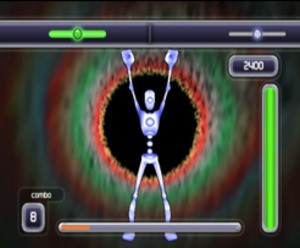
Our game is the first game out there to actually require two Wii Remotes for one player. No other game out there does that. Innovations like that really wouldn't be possible unless WiiWare existed. In case you're wondering the reason why we require two Remotes, it's because it's a two-handed game. You see a robot using two arms being punched in a circle. Originally we were thinking about having the player use one Nunchuk and one Wii Remote, as that would be the logical first step, right? What we found over time was that we had the game set to be a very high speed game, you're getting punches very quickly, sometimes as fast as four punches per second, we found that we would actually hit ourselves with the Nunchuk cord. The controls would be moving so quickly that the cord would actually hit us in the face or get caught around our neck and stuff like that. It was actually a health hazard.
The other thing we found was that some moves would actually snap the Nunchuk cord because the cord was too short. So if you can imagine doing a punch with your left hand to the left and then a punch with your right hand to the right, the Nunchuk cord wouldn't be long enough. So rather than create a subpar experience, where your hitting yourself in the face with the Nunchuk cord and you're snapping the Nunchuk cord we decided to just make it require two Wii Remotes and have that experience be really fun.
WW: When can we expect to see Helix released on the WiiWare service in North America and Europe and has a price been finalized?
ER: We're still working with Nintendo on the final price, so it's not finalized yet. We're thinking about 1000 Wii Points, around $10, as the price point, but they have the final say on that. As far as a release date, we just submitted the game to Nintendo yesterday for approval. It's going to be a few iterations back and forth to see if there's bugs to be fixed and things like that. We're expecting a Summer release, with a June/July timetable.
WW: Does Ghostfire Games have any other WiiWare projects currently planned or in development at this time?
ER: We're either going to make a sequel to Helix or we're going to make a completely different type of game in the second half of this year. We're planning to release two games per year, about one game every six months. That's how long it took us to make this game. So yeah, we're going to make another WiiWare game after this one.
WW: Thanks so much Ed for taking the time out of your schedule to do this interview for us. We look forward to playing Helix when it's released.
ER: Your welcome and thanks for taking the time to interview us.


Comments 14
What a fantastic interview. This has certainly changed my perception of this game, and the guy interviewed seems really on the ball. Nice work, Corbie!
I LOLed when I read the bit about the nunchuk cord hitting them in the face in testing. Yeah probably a better choice to use two Wiimotes!
Great interview Corbmeister! I think this game might be a nice cheap alternative to Wii Fit from the sounds of it.
Nice interview. June was to be expected.
......Wii Sports being a good exercise vechile? Are you serious? At least he could say Wii fit is a good exercise vechile. Well the good side to this is that he thinks that exercise is #2 in life (family,school and your beliefs being #1).
The price itself would get the person who bought it would get his money's worth of music . Hands down.
As for the interview, it was very good and sounded professional.
Ghostfire has an awesome name and logo.
Great interview Corbie!
CEO Ed saz... I think some of the best games I've seen in recent memory are games that have been simple to learn, but difficult to master
That echos Nolan Bushnell's mantra that a good game "should take a minute to learn, and a lifetime to master". Even then, I believe he was echoing an ancient Go proverb.
@thewiirocks
It is a Go proverb, very good!
As for this game, if its 26 songs for 1000, I'll get it (after I get another wiimote)
Changed my view for sure. I might buy. I think I will.
"(after I get another wiimote)"
You don't have wii play already? That is a wiimote plus ten mini games for ten extra bucks.
Thanks guys. I had a lot of fun with this interview. It was nice of Ed to take the time to do the interview. I'm excited to give the game a play. Maybe we won't have to wait too long since it's already been submitted to Nintendo.
@sailingtheseaoffools
You know, it's that kind of crummy attitude that made Wii Play one of the best selling games of the year, despite it's sub-par quality. I don't think it's right to support the release of garbage--oh wait, I bought Wii Play for the remote too
I'd kind of written this game off before, but this interview makes it sound kind of interesting! I wouldn't delete anything to make space for it (Im recently addicted to Pokemon Puzzle League, Dr. Mario, Toki Tori!) so I'd only get it if we see some kind of storage solution by june...
@objection_blaster...
For you it is a $50 game because of the second Wii-Mote! This isn't lookin' cheap to the lone gamer...
Just re-read this review. I'm really really hoping for a sequel. I'd get it as soon as it came out.
"One game every six months" - Looks like we may hear something soon!
Show Comments
Leave A Comment
Hold on there, you need to login to post a comment...